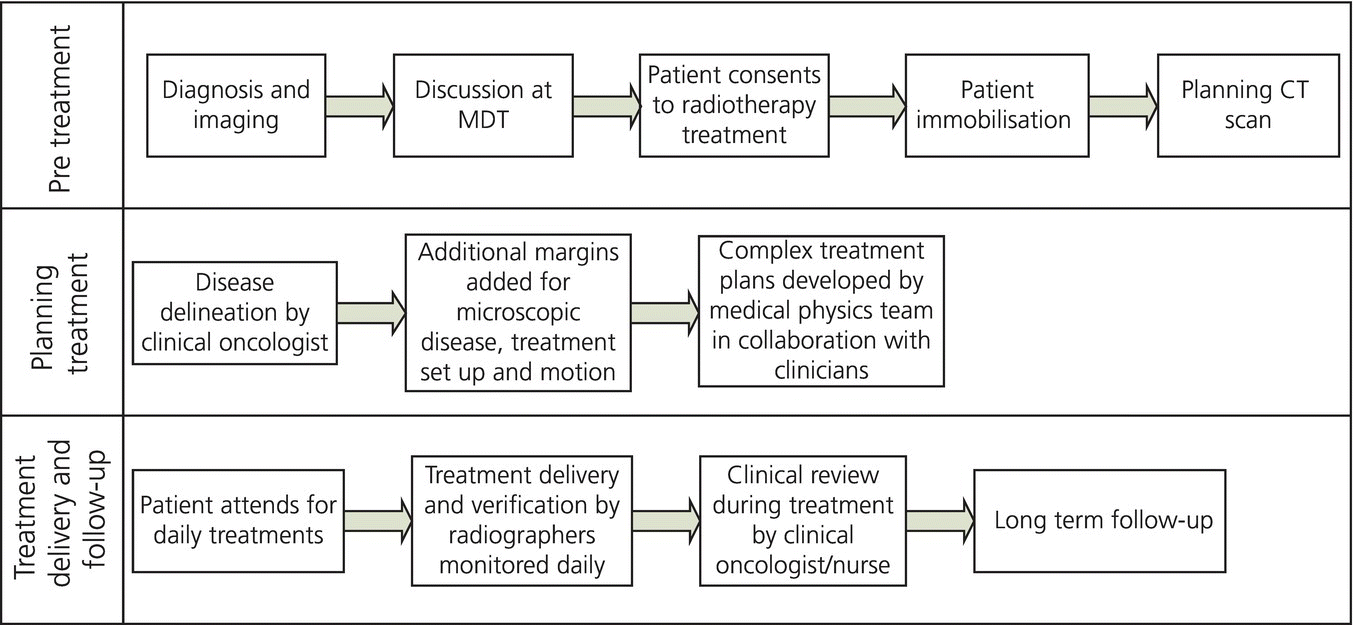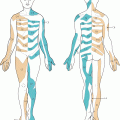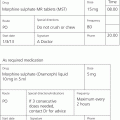Chapter 4
Introduction to radiotherapy
Emma Dugdale, Alexandra Gilbert and Robin Prestwich
St James’s Institute of Oncology, UK
Introduction to radiotherapy
Radiotherapy is the use of radiation in the management of cancer. Radiotherapy is a locoregional treatment with curative potential in the absence of distant metastatic disease. It forms part of the management of 40% of patients cured of their disease, but is also widely used to palliate symptoms. This chapter aims to provide an introduction to radiotherapy. The side-effects of radiotherapy are discussed in the next chapter.
Indications for radiotherapy
- Radical/curative: delivered as the sole treatment modality, for example prostate cancer. In locally advanced disease, radiotherapy may be combined with chemotherapy to improve efficacy.
- Neo-adjuvant: to improve the chances of curative surgery, for example pre-operatively for rectal cancer.
- Adjuvant: to reduce the risk of local recurrence following surgery, for example post-operatively for breast cancer.
- Palliative: palliation of symptoms and sometimes improved survival, when cure is not possible.
Radiotherapy dose and fractionation
- The absorbed dose of radiation within tissue is expressed in the unit gray (Gy).
- Commonly delivered as a series of smaller doses called fractions rather than as a single dose.
- The number of fractions and the dose given in each fraction (Gy) depends on the treatment intent:
- Radical/curative treatments require large doses of radiotherapy overall. The total dose is divided into multiple small fractions (often giving 2 Gy at a time daily Monday to Friday) to reduce the severity of acute and late toxicity, for example 70 Gy in 35 fractions over seven weeks for head and neck cancer.
- Palliative radiotherapy is delivered in a smaller number of fractions, giving more than 2 Gy per fraction but to a lower total dose, for example 8 Gy in 1 fraction or 30 Gy in 10 fractions.
- The dose and fractionation used for each tumour type and indication may vary from one treatment centre to another. Some examples of typical treatment regimes will be given in the following chapter.
Efficacy of radiotherapy
- Factors affecting tumour kill and toxicity:
- Total dose, total volume treated, dose per fraction, overall treatment time
- Comorbidities (e.g. diabetes, inflammatory bowel disease)
- Smoking – reduces efficacy and increases toxicity
- Radiogenomics
- Additional treatment modalities (chemotherapy, surgery, biological therapies)
- Gaps in radiotherapy treatment can reduce efficacy as tumour cells can proliferate during treatment. This is particularly important in fast growing squamous cell carcinomas, such as cervical, anal and head and neck cancers. Acute side effects are intensively managed to ensure that treatment can continue as prescribed.
- Chemoradiotherapy:
- Chemotherapy given during radiotherapy treatment is called concurrent chemotherapy or chemoradiotherapy.
- Concurrent chemotherapy is thought to act as a radiosensitiser, increasing the sensitivity of the cells to radiation.
- It leads to improved efficacy of the radiotherapy treatment, but also increases radiation-related side effects (in addition to the expected side effects of the chemotherapy).
Methods of delivery of radiotherapy
There are a number of different ways radiotherapy can delivered – external beam radiotherapy, brachytherapy and radioisotopes. The radiotherapy treatment process is shown in Figure 4.1.

Figure 4.1 Flow diagram of radiotherapy treatment process.
External beam radiotherapy
- This is the most common form of radiotherapy used in the UK and is delivered by a linear accelerator (see Figure 4.2). It can be given in two forms:
- Photons (high energy X-rays):
- Photons penetrate deep into body tissue where they produce secondary electrons that cause DNA damage to both cancer cells and normal cells.
- The majority of radiotherapy treatments use photons.
- Electrons







